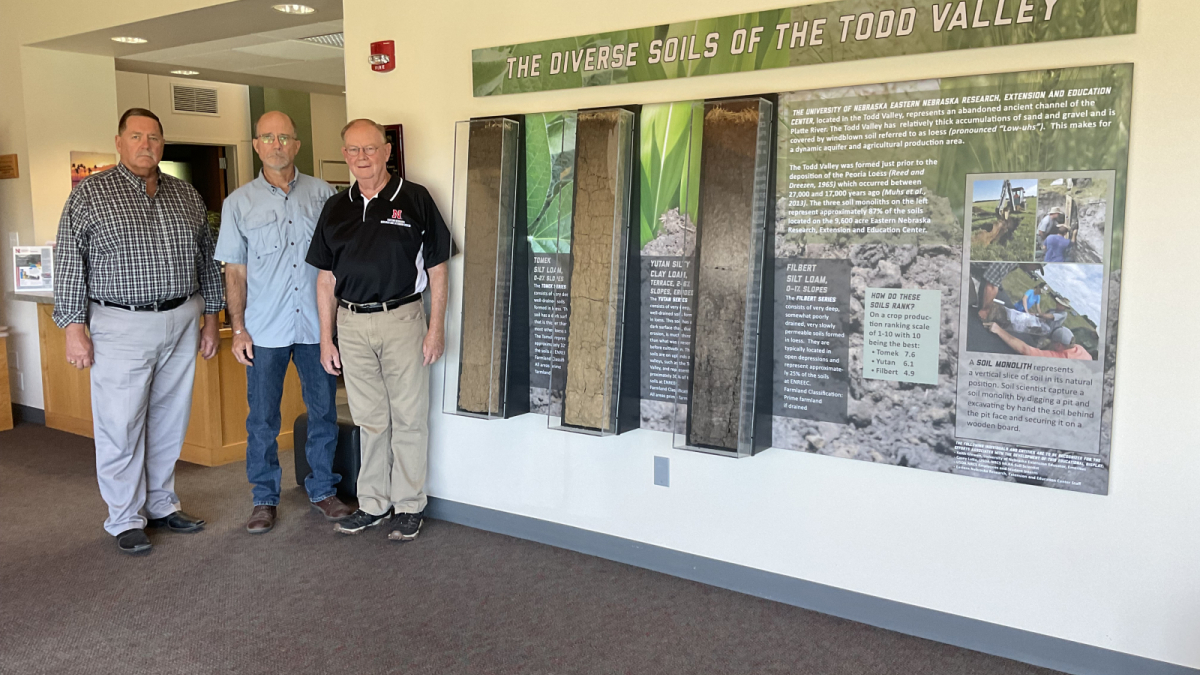by Deloris Pittman, Eastern Nebraska Research, Extension and Education Center

Lincoln, Neb. —What started as an extension educator’s passion for learning about soil has cumulated in a unique educational display for all to learn about soils. A new soil monolith display spearheaded by Emeritus Nebraska Extension educator Keith Glewen is now on display at the Eastern Nebraska Research, Extension and Education Center (ENREEC) near Mead, NE. The display is the result of a cooperative effort by Nebraska Extension, the United States Department of Agriculture Natural Resources Conservation Service (USDA-NRCS), and ENREEC.
Glewen developed an interest in soil as an undergraduate student participating in a collegiate soil judging team at the University of Wisconsin-Platteville. Taking part in contests across the country afforded him the opportunity to study soils in various regions. Glewen says, “Then I took a course in geomorphology where you learn about glaciers and volcanoes and earthquakes and things like that. And I started putting the puzzle together how soils were formed.”
Glewen incorporated soil conservation in many programs during his 45-year career with the University of Nebraska. This included collaborating with the USDA-NRCS on soil health focused Crop Management Diagnostic Clinics. Pits were dug to allow agronomists and producers to learn about physical, chemical and biological properties of soil. During a planning meeting with the USDA-NRCS, Glewen took note of the monoliths representing the soils across Nebraska displayed at the USDA – NRCS state office building and then again at the Raising Nebraska display at the Nebraska State Fair.
Glewen said, “I started to think about how unique the learning opportunity is when we teach agronomists using pits at the Midwest Soil Health Clinic at ENREEC, but how many more people we could reach if we had a permanent monolith display at the center.”
A soil monolith represents a vertical slice of soil in its natural position. In simplest terms, soil scientists capture a soil monolith by digging a pit and excavating by hand the soil behind the pit face and securing it on a wooden board. Casey Latta, USDA-NRCS MLRA Soil Scientist, provided the expertise in extracting and preserving the monoliths.
Latta says, “The purpose of our process is to preserve the soil slab as it exists in the field so that certain characteristics of the soil that can be observed.”
The process included mounting an extraction platform to preserve the slab in a soil pit. In a scene that might look somewhat like an archeological dig, excavation is done by hand behind the frame and then straps are run behind it to pull the core out. Once the soil core is out, it is laid flat on a board and protected with plastic wrap during transport. Latta says that two samples are extracted in case one would be damaged at some point.
Latta’s team carefully transported the extractions back to Lincoln. The soil cores were then mounted on boards with small brad nails and white glue. A layer of cheesecloth is utilized to help the soil adhere to the board. The entire sample is then preserved with a diluted white glue. According to Casey, It hardens and preserves the soil so it will stay in place.
The three soil monoliths on the display represent approximately 87% of the soils located at ENREEC: Yutan, Tomek and Filbert. ENREEC is located in the Todd Valley and represents an abandoned ancient channel of the Platte River. The Todd Valley has relatively thick accumulations of sand and gravel and is covered by windblown soil referred to as loess which makes for a dynamic aquifer and agricultural production area.
Not only can visitors observe the soil extractions up close in the new monolith display, but also they can learn about the productivity of the soils on the display.
ENREEC Director, Doug Zalesky says, “Displays like this are extremely valuable in the educational effort that we do here at the Eastern Nebraska, Research, Extension and Education Center. It is a great example of the educational efforts that we try to provide.” He also stated, “I think that's extremely important because soil is so very important to what we do here on this particular facility and in growing the food that we eat.”
The soil monolith display is permanently located in the lobby of ENREEC’s August N. Christenson Research and Education Building. Building hours are 8:00 a.m. – 4:30 p.m., Monday through Friday.